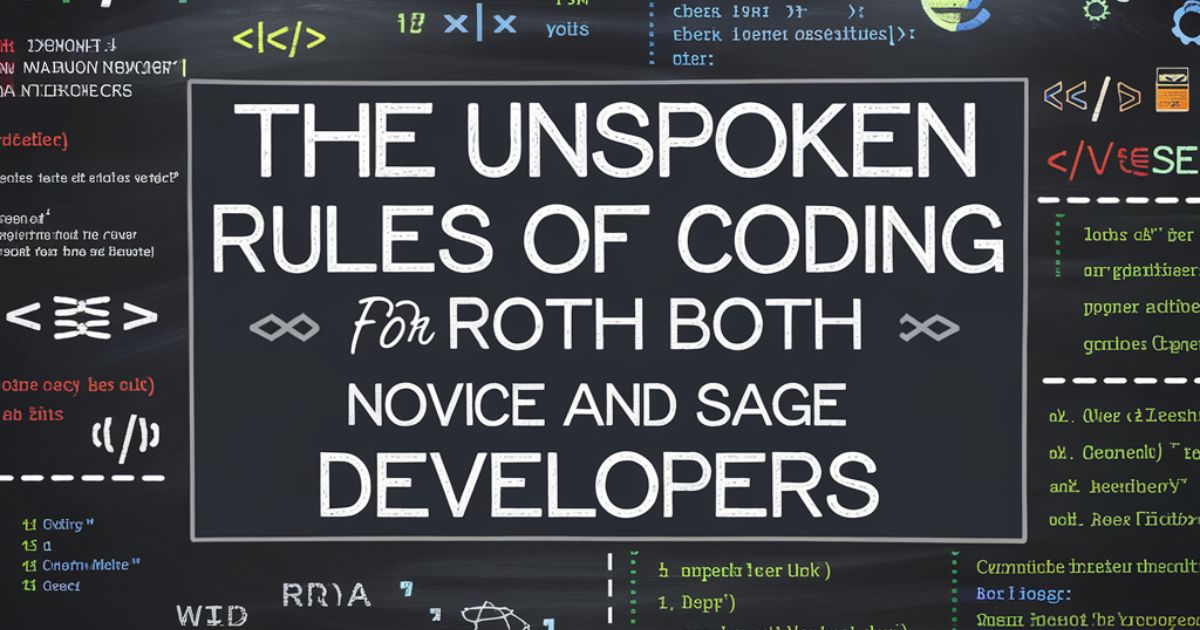In the dynamic landscape of software development, there exists a profound set of unwritten principles that transcend basic programming knowledge. These fundamental truths shape the way successful developers approach their craft, regardless of their experience level. While documentation and tutorials can teach syntax and structure, these unspoken rules form the backbone of truly exceptional software engineering.
Understanding the Foundation of Coding Excellence
The evolution from novice to sage developer encompasses far more than mastering programming languages or memorizing algorithms. It’s about developing an intuitive understanding of the subtle nuances that transform good code into exceptional code. This journey requires a deep appreciation for the principles that have emerged through decades of collective software engineering wisdom.
Today’s software development landscape demands more than just technical proficiency. It requires an understanding of how code impacts both machines and the humans who interact with it.
These timeless principles have been refined through countless hours of development, debugging, and collaboration across the global developer community.
Write Code for Humans, Not Computers

The most fundamental principle in modern software development often surprises newcomers to the field. While computers execute our instructions, it’s humans who must maintain, modify, and understand the code long after it’s written. This human-first approach transforms how we think about writing code.
Consider the typical lifecycle of code: it’s written once but read hundreds or potentially thousands of times by different developers throughout its existence. When you write code with human comprehension in mind, you’re investing in the future maintainability of your project.
This investment pays dividends through reduced debugging time, easier onboarding of new team members, and more efficient code reviews.
The principle of writing for humans manifests in various ways. Variable names should tell a story about their purpose. Functions should be concise and focused on a single responsibility.
Comments should provide context rather than merely restating the obvious. This attention to clarity and readability creates code that’s not just functional but truly professional.
Comments Should Explain Why, Not What
The art of commenting represents one of the most misunderstood aspects of coding. Effective documentation goes beyond simply describing what the code does – it explains the reasoning behind important decisions and complex implementations. This distinction makes the difference between comments that clutter code and those that provide genuine value.
Here’s how different types of comments impact code understanding:
| Comment Type | Value Added | Example | Impact on Maintenance |
| Implementation Details | Low | “Increment counter” | Creates noise, becomes outdated |
| Business Logic | High | “Ensure GDPR compliance” | Provides crucial context |
| Architecture Decisions | High | “Chosen for scalability” | Helps future modifications |
| Performance Considerations | Medium | “Cached for speed” | Guides optimization |
| Edge Cases | High | “Handles timezone differences” | Prevents future bugs |
Don’t Repeat Yourself (DRY)
The DRY principle stands as a cornerstone of sustainable development, yet its implications run deeper than most novice developers realize. While the surface-level interpretation suggests avoiding copied code, the true essence of DRY encompasses the broader concept of knowledge duplication within systems.
When developers talk about DRY, they’re really discussing the concept of having a single source of truth. Every piece of business logic, every validation rule, and every calculation should exist in exactly one place within your codebase. This approach not only reduces the likelihood of errors but also makes systems more maintainable and adaptable to change.
Consider a real-world scenario: an e-commerce platform that handles shipping calculations. If shipping rules exist in multiple places throughout the code, updating those rules becomes a risky endeavor. A single missed update could lead to inconsistent behavior and frustrated users. By centralizing these rules, we ensure consistency and simplify maintenance.
Learn to Fail Gracefully (Error Handling)

Error handling represents the difference between amateur and professional applications. Robust error management isn’t just about catching exceptions – it’s about creating systems that degrade gracefully under unexpected conditions while maintaining a positive user experience.
Professional error handling involves multiple layers of consideration. At the user interface level, errors should be presented in clear, actionable terms that help users understand and resolve issues.
At the system level, errors should be logged with sufficient context for debugging while protecting sensitive information. At the architectural level, systems should be designed to maintain stability even when individual components fail.
The concept of failing gracefully extends beyond just handling exceptions. It includes input validation, boundary checking, and graceful degradation of features when dependencies are unavailable. This comprehensive approach to error management creates resilient systems that maintain user trust even when things go wrong.
Test Early and Often
The philosophy of early testing represents a fundamental shift in how modern developers approach software creation. Proactive testing isn’t just about finding bugs – it’s about designing better systems from the ground up.
When you write tests early in the development process, you’re forced to think about how your code will be used, what might go wrong, and how to structure your solutions effectively.
Testing early influences architectural decisions in positive ways. It pushes developers to write more modular, loosely coupled code that’s easier to test and maintain.
This approach often reveals design flaws early when they’re less expensive to fix. The practice also provides a safety net that makes refactoring and optimization much safer.
The concept of “often” in testing goes beyond just running tests frequently. It means continuously expanding your test suite as you add features, fix bugs, and discover edge cases.
Each production issue should lead to new test cases that prevent similar problems in the future. This growing suite of tests becomes a living documentation of your system’s expected behavior.
Also Read: MaintainX 50M Series 1B 191MRoofBloomberg: Key Insights
Refactor Regularly
Regular refactoring serves as preventive maintenance for your codebase. Just as a garden needs constant attention to prevent weeds from taking over, code requires regular cleanup to prevent technical debt from accumulating. This isn’t about making changes for the sake of change – it’s about maintaining and improving the health of your codebase over time.
Effective refactoring follows patterns and rhythms. Small improvements happen continuously as part of the normal development cycle. Larger refactoring efforts are planned and executed strategically, often in conjunction with feature work. The key is maintaining a balance between perfect code and practical delivery schedules.
Key areas to focus on during refactoring:
- Simplifying complex methods
- Removing duplicate code
- Improving naming conventions
- Optimizing database queries
- Updating deprecated dependencies
Use Version Control Properly
Version control is more than just backing up code. It’s about maintaining a clear history of your project’s evolution and enabling effective collaboration. The way you structure your commits and branches can make or break a project’s maintainability.
Here are essential version control practices:
# Example of a well-structured Git workflow
git checkout -b feature/user-authentication # Create feature branch
git add src/auth/* # Stage related changes
git commit -m “feat: Implement OAuth2 authentication
– Add OAuth2 provider integration
– Implement token refresh mechanism
– Add user session management
– Update security middleware”
Know When to Stop Optimizing
The pursuit of perfect code can be a trap. As Donald Knuth famously said, “Premature optimization is the root of all evil.” Focus on making your code work correctly first, then optimize based on actual performance metrics.
Performance Optimization Priority Matrix:
| Impact | Effort | Priority | Example |
| High | Low | 1 | Indexing frequently queried database columns |
| High | High | 2 | Rewriting core algorithms |
| Low | Low | 3 | Minor code tweaks |
| Low | High | 4 | Complete system rewrites |
Understand Your Tools and Ecosystem
Mastery of your development environment and tools is crucial. Modern development involves numerous tools and frameworks working together. Understanding their capabilities and limitations helps you make better architectural decisions.
Essential aspects to master:
- IDE capabilities and shortcuts
- Debugging tools and techniques
- Package managers and dependency management
- Build tools and deployment pipelines
- Monitoring and logging systems
Communicate Effectively with Your Team
Technical excellence alone isn’t enough. The ability to communicate effectively with team members, stakeholders, and users is crucial for project success.
Best practices for technical communication:
# Example of clear code documentation
class PaymentProcessor:
“””
Handles payment processing across multiple providers.
This class serves as a facade for various payment gateways,
providing a unified interface for payment processing while
handling provider-specific implementation details.
Example usage:
processor = PaymentProcessor(config)
result = processor.process_payment({
‘amount’: 100.00,
‘currency’: ‘USD’,
‘payment_method’: ‘credit_card’
})
“””
Don’t Fear Technical Debt—Manage It

Technical debt is inevitable in any growing project. The key is not to avoid it completely but to manage it strategically. Some technical debt is acceptable when it helps meet critical business needs.
Signs that technical debt needs immediate attention:
- Increasing bug reports
- Slowing development velocity
- Rising maintenance costs
- Difficulty onboarding new team members
- Frequent production incidents
The Path to Continuous Growth
Professional development never stops in software engineering. The most successful developers maintain a growth mindset and continue learning throughout their careers.
FAQ’s
What are the unspoken rules of coding?
The unspoken rules encompass best practices that go beyond basic syntax and documentation. They include writing human-readable code, effective commenting, proper error handling, and maintaining a balance between perfectionism and practicality.
How do novice developers approach coding differently from experienced ones?
Novice developers often focus on making code work, while experienced developers prioritize maintainability, scalability, and readability. The difference lies in thinking about long-term implications rather than just immediate solutions.
Why is readability more important than cleverness in code?
Readable code saves countless hours in maintenance and debugging. While clever solutions might seem impressive, they often create maintenance headaches. Consider that code is read far more often than it’s written, and typically by developers who didn’t write it originally.
What’s the importance of commenting code, and how should it be done?
Strategic commenting provides crucial context about why certain decisions were made. Rather than explaining what the code does, focus on documenting:
- Business logic rationale
- Complex algorithm explanations
- Warning about edge cases
- Dependencies and requirements
- Future improvement notes
Why is the DRY principle crucial for developers?
The DRY principle reduces maintenance overhead and potential bugs. When code is duplicated, changes must be made in multiple places, increasing the risk of inconsistencies. Centralizing logic means:
- Easier maintenance
- Consistent behavior
- Reduced testing burden
- Smaller codebase
- Better scalability
How should developers handle errors in their code?
Effective error handling requires a comprehensive approach that includes:
def process_transaction(data):
# Validate input
validated_data = validate_transaction_data(data)
# Process with proper logging
logger.info(f”Starting transaction processing for ID: {data[‘id’]}”)
result = perform_transaction(validated_data)
# Handle success
logger.info(f”Transaction {data[‘id’]} completed successfully”)
return result
except ValidationError as e:
# Handle validation errors gracefully
logger.warning(f”Validation failed: {str(e)}”)
notify_user(f”Please check your input: {str(e)}”)
raise
except TransactionError as e:
# Handle business logic errors
logger.error(f”Transaction failed: {str(e)}”)
notify_support_team(e)
raise
What role do tests play in coding practices?
Testing serves multiple crucial functions in modern development:
- Validates functionality
- Documents expected behavior
- Catches regressions early
- Enables confident refactoring
- Improves code design
Final Thoughts
Success in software development comes from more than just technical knowledge. It requires judgment, communication, and a deep understanding of these unwritten principles. Whether you’re just starting or have years of experience, keeping these guidelines in mind will help you write better code and build better software.
Remember: The goal isn’t to follow these rules blindly, but to understand their underlying principles and apply them thoughtfully to your specific context. As you grow in your development journey, you’ll find yourself naturally incorporating these practices into your daily work.
Additional Resources
For continued learning and growth:
- Join developer communities
- Contribute to open source projects
- Read technical blogs and books
- Attend conferences and workshops
- Practice code reviews
- Share knowledge with others
By embracing these unspoken rules and continuing to learn, you’ll not only become a better developer but also contribute to the broader software development community.
Explore the latest news and insights from Echozynth and beyond at Echozynth.com

Kiara Arushi is the dedicated admin of this personal website, which serves as a comprehensive hub for general information across various topics. With a keen eye for detail and a passion for knowledge sharing, Kiara curates content that is both informative and engaging, catering to a diverse audience.
Her commitment to providing accurate and up-to-date information ensures that visitors find valuable insights and practical tips in every post. Whether you’re seeking the latest trends or timeless advice, Kiara’s expertise makes this site a trusted resource for all.


